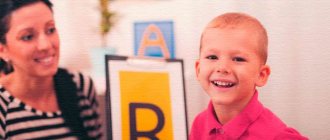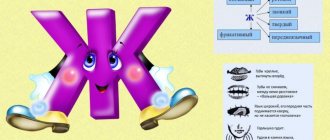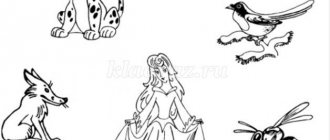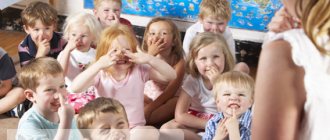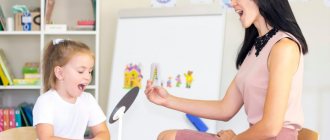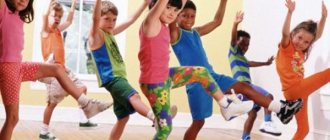Lesson 1
Spatial orientation Cross orientation. - Place your right hand on your left shoulder. Place your left hand on your right knee. Touch your left ear with your right hand. With your left hand touch your right cheek. “We go up the mountain, we go down the mountain.” Pronunciation of syllables in combination with movements of the index finger. Exercise for developing a long exhalation “Let's warm up our hands.” Take a deep breath through your nose. Round your lips and exhale forcefully through your mouth. A warm air stream should be felt. Repeat 3-4 times. Lip exercise “Surprise”. Round your lips and pull them forward. Make the sound [o]. Exercises for the tongue “The tongue looks for a crack in the fence.” Insert a wide tongue into the gap between the teeth. "Spatula". Smile, open your mouth slightly, place the wide front edge of your tongue on your lower lip. Hold in this position for a count of up to 10. Coordination of breathing, articulation and phonation Game tasks “The boat rocks on the waves.” Drawing wavy lines in a box of millet cereals. Development of phonemic perception Isolating the sound [w] from a number of sounds that are distant in terms of acoustic and articulatory characteristics. Sounds: [v], [w], [l], [sh], [p], [b], [f], [sh], [m], [n], [sh]. Syllables: la, sha, fu, wu, po, ko, by, gy. The words hat, lump, fur coat, jar, shirt, raspberry.
Lesson 2
Exercise for developing a long exhalation “Football”. Take a breath. Smile and place the wide front edge of your tongue on your lower lip. Using an exhaled air stream, drive the cotton ball into the “gate”. “Let’s put out the candle.” Exhale evenly and slowly into the candle flame. Pronouncing the vowel sounds a-i, a-u, e-s-o on one exhalation with exaggerated articulation. Exercises for lips “Wide tube”. Close your teeth. Round your lips extended forward. The corners of the lips do not touch. Lips do not cover teeth. Hold your lips in this position for a count of up to 6. Exercises for the tongue “Delicious jam”. Open your mouth slightly. Using the wide front edge of your tongue, lick your upper lip, moving your tongue from top to bottom. Repeat 5-6 times. “The tongue goes to visit the nose.” Open your mouth slightly, lift the wide front edge of your tongue towards your nose. Hold it in this position for a count of 5-6. “Teeth and tongue playing hide and seek.” Open your mouth slightly, cover your upper teeth with your tongue. Development of switchability of the organs of the articulatory apparatus and development of coordinated work of the lips and tongue “Conversation between the Cuckoo and the Owl.” Pronouncing syllables and sounds ku-ku, ku-ku, ku-ku; uh-uh, uh-uh, uh-uh with a change in intonation. Development of phonemic perception Isolation of the sound [w] among sounds that are similar in acoustic and articulatory characteristics, against the background of syllables and words. Sounds: [s], [sh], [z], [s], [sh], [ts], [zh], [s]. Syllables: sa, for, zha, so, sha, tso, su, shu, zy, shi, sy. The words cuckoo, owl, sparrow, fox, beetle, bumblebee, etc. The child raises his hand or claps his hands if he hears the sound [w].
What prevents a child from “hissing”?
There are two groups of reasons why babies fail to pronounce the sound “Ш” correctly. Physiological reasons include:
- Insufficient development and immobility of the articulatory apparatus;
- Malocclusion (often caused by prolonged use of a pacifier);
- Short frenulum of the tongue;
- High palate;
- Oral diseases;
- Difficulties in phonemic perception (the child does not distinguish some sounds by ear);
- Hearing impairment;
The second group of factors are the mistakes of adults who are around the child.
- “Lisping” from adults;
- Incorrect pronunciation by adults (children always repeat after us).
Lesson 3
Exercise to develop a long exhalation: Close your wide tongue on your upper lip, bring a strip of paper (just above your nose). Blow on a paper plume (the air stream should go obliquely upward). "The plane is buzzing." Pronunciation of the sound [u] with changes in the pitch and strength of the voice. Exercise for lips Alternating exercises “Smile” and “Pipe”. Exercises for the tongue “The tongue swings on a swing.” Open your mouth wide, raise your wide tongue to your nose, then lower it to your chin. “Let’s hide our teeth.” Cover the upper teeth with a wide tongue, then the lower ones. “Glue on some candy.” Place a piece of candy on the edge of your tongue sticking out of your mouth. Suggest sticking it to the roof of your mouth behind your upper teeth. Development of switchability of the organs of the articulatory apparatus and development of coordinated work of the lips and tongue “Playing the drum.” Pronouncing syllable combinations ta-da, ta-da, ta-da, ta-da, you-dy, you-dy, you-dy with the movement of the index fingers of both hands. Development of phonemic awareness Definition of the sound [w] in words. Find toys that have the sound [sh] in their names. (Matryoshka, rattle, Cheburashka, bear, machine, ball.) Determining the position of the sound [w] in the words ball, bear, baby.
Breathing exercises
Performed after articulation gymnastics. The following game-based speech therapy exercises are recommended for establishing the sound Ш:
- "Football". The speech therapist places a cotton ball on a horizontal surface and invites the patient to score a goal into an improvised goal with a stream of air. But the cheeks cannot be inflated; the air is blown out only with the participation of the lips folded into a pipe. It is advisable for the speech therapist to hold the child’s cheeks with his palms during the exercise. The exhalation should be such that a solid, even air flow comes from the mouth.
- "Butterfly" on a flower. A butterfly and a flower are cut out of colored cardboard and connected. The speech therapist asks the patient to blow the butterfly off the flower in a manner similar to the above.
Lesson 4
Exercise for developing a long exhalation “Focus”. Place a piece of cotton wool on the tip of your nose. Smile, open your mouth slightly. Place the wide front edge of the tongue on the upper lip so that its side edges are pressed and there is a “groove” in the middle. Blow off the cotton. The air should flow through the middle of the tongue, then the cotton wool will fly upward. Lip exercise “Elephant trunk”. Round your lips and pull them forward. Hold your lips in this position for a count of up to 6. Exercises for the tongue “Swing”. Raise and lower your wide tongue behind your teeth, touching it with the tip of the upper gum, then the lower gum. Place the tip of your tongue under your upper lip, then tear it off with a click. "Cup". - Prepare a “cup”, I will treat you with juice. What juice will you drink? — Open your mouth slightly, place your wide tongue on your lower lip, then lift the tip and lateral edges of the tongue upward; a depression should form in the middle part of the tongue. Development of the voice, switchability of the organs of the articulatory apparatus and the development of coordinated work of the lips and tongue “Conversation of the Naf-Naf and Nuf-Nuf piglets.” Pronouncing the syllables na-na-na, ny-ny-ny, well-well-well, but-but-but with a change in stress and intonation (fearful, confident, angry, calm). Development of phonemic perception Find pictures on the topic “Clothing”, the names of which contain the sound [w]. Determining the position of the sound [sh] in the words hat, scarf, shirt, pants, shower. Arrange the pictures on the typesetting canvas. Place objects in the names of which the sound is heard at the beginning of the word on the top strip, on the middle - those whose names have the sound in the middle, on the bottom - those whose names have the sound at the end.
Diagnostics
It is important to assess how well all components of speech are formed. If there are deviations, speech therapists pay special attention to the appearance of the lips, the tone of the tongue, the state of the bite, the work of facial and articulatory muscles, and the force of exhalation. Standard diagnostic exercises in speech therapy:
- Please show emotions: joy, surprise, sadness.;
- Stretching the lips with a tube and fixing them in a certain position;
- Movements of the jaw in different directions, attempts to relax the tongue, make it wide/narrow;
- Blowing away a light object, playing the pipe;
- Pronunciation of phonemes separately, as well as in words and phrases;
- Compose a story from the given words and pictures.
Based on the results of the examination, suitable exercises are selected for performance. You can use the classic options, widely used in speech therapy.
Lesson 5
Exercise for developing a long exhalation “A strong wind blows leaves.” Place a wide tongue (“spade-toy”) on the lower lip. Blowing with the formation of a “groove” along the midline. Lip exercise “The trunk of a big elephant and a small elephant.” Alternating wide and narrow “tubes”. Exercises for the tongue Repetition of exercises from previous lessons. "We're riding a horse." Clicking the tongue. The wide tip of the tongue is sucked to the palate and comes off with a click. "Rose petal". The tongue is cupped on the outside, then inside the mouth. Make sure that the lateral edges of the tongue are pressed against the upper molars. Development of switchability of the organs of the articulatory apparatus and development of coordinated work of the lips and tongue “Conversation of Hippos.” Pronouncing syllable combinations bda-bda, bdo-bdo, bdu-bdu, bdy-bdy; bda-bdo-bdy, bda-bda-bdu-bdy with a change in intonation. Development of phonemic perception Determination of the position of the sound [sh] in the words Shura, Masha, Natasha, kre-pysh, shorty, silly, naked.
Reasons for the absence of the correct "Sh"
If we are talking about a healthy child with normal hearing and intact intelligence, the following reasons for distorted sound pronunciation are identified:
- Incorrect speech breathing. If there are breathing problems, the child’s speech remains quiet, he stumbles over every word, and the end of the sentence is swallowed due to lack of air. The same process is observed in sound pronunciation; many sounds are distorted due to difficulty in speech breathing. You can notice difficulties when the exit during a conversation is sharp, through the nose. The child can also take small breaths to finish the sentence. You can practice at home. With daily practice that lasts no more than five minutes, the results will appear within a month, which will significantly speed up the process of sound production.
- The problem is speech hearing. Thanks to phonemic hearing, it becomes possible to distinguish consonant words. A deviation occurs when a child does not notice differences in his pronunciation from other people. Impaired speech hearing leads to difficulties in learning to write and read. In some cases, dyslexia develops. The formation of speech hearing should be addressed from the moment of pregnancy, when auditory receptors begin to form in the fetus. Phonemic hearing develops by the age of four, so if after this age the child still pronounces sounds incorrectly or does not agree on the endings in words, this is a reason to contact a specialist. A comprehensive examination and medical history will help to more accurately determine the direction of correcting the disorder.
- Poor development of the articulatory apparatus. The quality of sound pronunciation depends on the functioning of the speech apparatus and the individual work of the organs of the oral cavity. Sounds are formed in the oral cavity, so the correct location of the organs that are responsible for speech plays an important role in sound pronunciation. Incorrect structure may include an incorrect bite, the structure of the palate, or the formation of teeth. All this leads to the formation of blurred speech, unclear pronunciation of words and sounds. For accurate sound pronunciation, it is necessary to develop motor activity of the tongue, lip mobility (smile, rounding), and fixity of the lower jaw.
- Individual structure of the frenulum. All people have different lengths of the hyoid frenulum. Problems with the correct production of sounds may arise if parents notice that the child does not reach the upper palate with his tongue, the tip of the tongue does not protrude, and the child cannot make a clicking sound. A short frenulum prevents the sucking reflex and creates an incorrect bite. You can correct the problem with the help of a speech therapist or dentist. Surgery to trim the frenulum is required for children who exhibit a lump or attachment to the actual tip of the tongue. In cases where structural problems have not been identified, they suggest developing the ligament with special exercises and massage. Usually, problems are identified during examinations of newborns, who can have their frenulum cut immediately in the maternity hospital.
Lesson 6
Exercise for developing a long exhalation “The wind is noisy.” Place the bottle upside down at nose level. Raise your wide tongue to your upper lip and blow strongly on your tongue. Noise is heard in the bubble. "The baby elephant drinks some water." Make a “proboscis”. Inhale and exhale air through your mouth. Lip exercises Repetition of exercises from previous classes. Development of coordinated movements of the lips and tongue. Extend the lips into a “tube” and the tongue into a “cup” (outside the mouth). Exercises for the tongue Repetition of exercises from previous lessons. "Harmonic". Smile, open your mouth slightly. Glue your tongue to the roof of your mouth, then, without lowering your tongue, close and open your mouth. As you repeat the exercise, open your mouth wider and hold your tongue longer. Development of switchability of the organs of the articulatory apparatus and development of coordinated work of the lips and tongue. Hippo Booby learns to pronounce the syllables bdi-bdi-bdi, bdi-bde, bdya-bde, bde-bdya-bdi. Development of phonemic perception Selecting pictures whose names contain the sound [w] from other pictures whose names contain [s] and [z]. The teacher pronounces the words, and the child chooses pictures whose names contain the sound [w]. Producing the sound [sh] The position of the organs of the articulatory apparatus when pronouncing the sound correctly [sh] The lips are slightly rounded and stretched forward in a “tube”. The teeth are brought together at a distance of 1-2 mm. The tip of the tongue is raised in a “cup”, but does not touch the palate. The lateral edges of the tongue are pressed against the upper molars, and the middle of the front of the tongue forms a semilunar fissure with the palate just behind the alveoli. The soft palate is raised, the vocal cords are open. The exhaled air stream is strong. If you put the back of your hand to your mouth, you feel warmth. Techniques for producing sound [w] Auditory perception of sound. Creating an auditory image of the sound “Noisemakers”. Onomatopoeia The sound of the wind in the forest; the rustle of leaves on the trees; rustling of dry leaves; rustling of dry hay or straw, paper; the hiss of a gander, a snake; the rustling of mice in a hole, tires on the pavement; the sound of air escaping from a punctured balloon, a locomotive releasing steam. Formation of a visual image of the sound [w] Showing the articulatory profile. Clarification of the position of the lips, teeth and tongue. Description of the position of the organs of articulation. Forming a sense of the position of the organs of articulation with the help of toys. Look how the monkey lifts its tongue “cupped” by its upper teeth. Demonstration of correct articulation of the sound [sh]. Draw the child's attention to the position of the lips, teeth and tongue. Plastic representation of the shape of the tongue with the hands. With your right hand, depict the shape of the tongue as a “cup”, and with your left hand, the palate. Setting the sound [w] according to R.I. Levina (1965) Setting the sound [w] by imitation Raise the tongue to the upper lip and exhale air evenly, forcefully, controlling the air stream with the back of the hand. Having achieved the release of a warm stream of air from the position of the tongue at the upper lip, move the tongue over the upper teeth to the palate with the mouth open. Round your lips and stretch them forward, bring your teeth together at a distance of 1-2 mm and exhale. The sound should be [w]. Setting the sound [w] based on the sound [t] Pronounce the sound [t] several times at intervals of 2-3 seconds. Then the setting is given: the tongue “knocks” not on the teeth, but on the tubercles (alveoli). The sound [t] is pronounced at first with an aspiration, while a weak and short hissing sound is mixed with the sound of the explosion. Round your lips and extend them forward, raise your tongue to the front of the palate. Press the lateral edges of the tongue against the molars. Transition from the sound [t] to the sound [w]: t-t-tshshsh. Subsequently, the noise lengthens and is freed from the previous sound [t]. Setting the sound [w] on the basis of the sound [r] Pronounce the drawn-out sound [r] without a voice or in a whisper, gradually reducing the force of exhalation until the vibration stops and a faint hiss appears. With repeated exercises, the sound [w] is obtained without the previous pronunciation of a dull sound [r]. Hissing can be obtained by touching the lower surface of the tongue with a spatula, slowing down the vibration of the tongue. Setting the sound [w] on the basis of the sound [s] Place the tongue behind the lower teeth. Invite the child to pronounce the sound [s]. At the same time, use a spatula or probe to lift the tongue upward. Using the fingers of your right hand, lightly press on your cheeks and push your lips forward. Instead of a whistle, you should get a hiss. You can invite the child to repeat the syllables sa, so, sy, asa, asy, as, os while simultaneously lifting the tongue with a probe or spatula. Setting the sound [w] on the basis of the sound [h] Pronounce the sound [h] followed by a long exhalation. You should feel a warm stream of air on your hand brought to your mouth.
Setting the sound Ш mechanically
One of the effective ways of producing the sound Ш is using a speech therapy probe. The action plan is as follows:
- The child pronounces the long sound C with a high tongue position. The lips should be stretched in a smile so that the upper and lower incisors are visible. There should be a small distance between the teeth.
- When pronouncing C, the speech therapist inserts a probe into the patient’s mouth and presses it on the tip of the tongue. He tries to push the tongue deeper so that a hissing shade is formed.
- The child squeezes the probe with his teeth, not stopping hissing.
- The specialist forms a tube from the child’s lips, squeezing the corners of the mouth with his fingers. The result is a clear sh sound.
Then the little patient can train independently in front of a mirror.
Gradually, training using a probe needs to become more complicated, moving from simple hissing to pronouncing hissing syllables and words.
Lesson 1
Automation of the sound [sh] in open syllables Development of articulatory motor skills Note. In further work, articulation exercises are carried out taking into account the individual characteristics of the child’s motor skills and the nature of his speech impairment. Development of memory, attention Memorization and reproduction of syllables in combination with the movement of the fingers. Game tasks “Fingers walk on the table”: sha-sha, sha-sha; sha-sha-sha, sha-sha-sha, sha-sha-sha; shi-shi, shi-shi. "Conversation between a mouse and a mouse." Pronouncing syllables with a change in intonation: shi-shi-shi, shi-shi-shi, shi-shi-shi; sha-shi-sho-shu; shi-sha-sho-shu. - Which syllable is extra? Sha-sha-sha-shi, sha-sha-sha-sa. “Let’s come up with names for the dolls.” Ma...(sha), Da...(sha), Sa...(sha), Mi...(sha), Nata...(sha), Katya...(sha). - Complete the syllable. We... (shi), small... (shi), kama... (shi), pi... (shu). - Which syllable is missing? Ma...na (shi). Analysis and synthesis of syllables What is the first sound in the syllable sha? Name the second sound. The sound [sh] alone is boring. Let's invite the sound [u] to it. The sound [w] has become friends with the sound [y]. What syllable did you get? - Find a picture whose title contains the syllable shu. (Fur coat, joke.) Introducing the letter sh
Possible deviations
During the examination, it can be revealed that the sound “Ш” is pronounced incorrectly. Despite the fact that this sound is considered dull, it must be pronounced clearly and cleanly.
Possible deviations:
- The child sticks his tongue out too much between his teeth, resulting in a lisping sound.
- Sigmatism in “Ш” appears when there is strong tension in the deep part of the tongue. Then “W” is replaced by “X”.
- With lateral sigmatism, a “pop” is produced.
- Dental parasigmatism - the tongue rests on the upper incisors. Instead of "W" you get "T".
- With labiodental parasigmatism, “W” sounds like “F”.
- Instead of "SH" sounds "S", this is whistling parasigmatism.
It is important to tell your child how the speech organs should be positioned correctly. Classes should be accompanied by visual analogies and demonstrations.
Lesson 2
Automation of the sound [sh] in reverse syllables Development of articulatory motor skills Work on the voice Pronunciation of the syllables ish-ish-ish, ish-ish-ish, ash-ash-ash, osh-osh-osh, ush-ush-ush on behalf of the heroes of the fairy tale “ Masha and the Bear" (with a change in intonation). Memorization and reproduction of syllable series ish-ish-ash, ish-ish-ash, ish-ish-ash-ush, ish-ish-ash-ush Analysis and synthesis of syllables - Repeat the syllables sha-shi-sho. Listen again. Sha-shi. Which syllable disappeared from the series? (Sho.) Sho-shu-shi-sha. Sho-shu-shi? (Sha.) - Listen and repeat the syllables ish-ish-ish. What new syllable appeared? Ish-ish-ash. - Let's “make friends” two sounds - the vowel [a] and the consonant [w]. What syllable will be produced if the first sound is [a], and next to it is [w]. Indicate sounds with color symbols (red and blue circles). - What is the first sound in the syllable ish? What's the second sound? - Name the second sound in the syllable osh? Composing the syllables ish, ish, ash from letters of the split alphabet. Development of phonemic perception Game “Speech Lotto”. Selection of pictures whose names contain the sound [w] from a number of others. The teacher names the words, and the child finds pictures with the sound [w].
Promoting speech development in children
In order for the child’s speech to develop correctly, in accordance with age, parents, in consultation with a speech therapist, must carry out the following work:
- create a favorable communication environment, speak clearly and competently, do not distort words;
- Explain to your child all your actions (this is important for quickly mastering concepts);
- gradually generalize concepts, form semantic connections;
- show manipulations with various objects, ask them to repeat and pronounce their actions;
- play with the child, read with him.
The production of the sound Ш is carried out in stages; it is necessary for the formation of beautiful and clear speech. Classes are held not only with a speech therapist, but also at home. To quickly achieve a positive result, it is recommended to work with the child 2 – 3 times a day.
Lesson 3
Automation of the sound [w] in syllables (intervocalic position) Development of articulatory motor skills “The little mice are whispering.” Pronouncing syllable combinations yshi-yshi-yshi, asha-asha-asha, usha-usha-usha, ishi-ishi-ishi, osho-osho-osho, ashu-ashu-ashu, oshi-ishi-ashi on behalf of the little mice (including facial exercises). Development of phonemic perception - Name the place of sound in the syllables sha, ash, asha. Where is the sound [w] heard in the words Shun (mouse's nickname), mouse, mouse?. Reading the syllables sha, sho, shi Development of auditory memory and attention Following instructions of 2-3 actions. - Go to the closet. Take the mouse. Place the mouse between the matryoshka doll and the horse, and then sit down.
Lesson 4
Automation of the sound [ш] in syllables with a combination of consonants Development of articulatory motor skills Working on the voice Memorizing and reproducing a syllabic series in combination with movement. Game exercise “We are weightlifters.” Shta-shta, shta-shta; piece-piece-piece-piece (raise and put down the barbell). "Conversation between Cheburashka and Tumbler." - What, what, what. (angrily) - Shty-shty-shty? (Good-naturedly. Why are you so angry?) - Wow. (Affectionately. Let's be friends.) - What-what-what? (Interrogative. Do you agree?) - What-thing-thing-thing. (Affirmative. I agree.) Development of phonemic awareness - Find pictures whose names contain the sound [w], and put them next to the letter w. Pictures are laid out in front of the child, the names of which contain the sounds [w] and [z]. The teacher names the words, and the child finds the desired picture. Determining the position of a sound in two or three words. Reading the syllables ush, shu; oh, sho
When to see a speech therapist
Distortion and replacement of sounds in three-year-old children is not considered a deviation. But if at 2 years old the child has no speech, then it is worth going to a consultation with a specialist. Only by the age of 5 does the formation of the phonetic series end. The setting of "Sh" occurs between the third and fifth years of life.
Violation of the pronunciation of “Ш” is correctable and is often eliminated relatively easily. The main thing is that classes are regular and systematic. It is important that the little student himself has the desire to correct his speech and pronounce “Sh” correctly.
The child and parents must show patience and perseverance during lessons. If the results are poor, then you should contact a speech therapist. A specialist can place “Ш” from the reference sound with mechanical assistance, using a probe or spatula.
Lesson 5
Automation of the sound [ш] in syllables with a combination of consonants Development of articulatory motor skills Work on the voice Game exercise “Conversation of monkeys.” Memorizing and reproducing syllables with the inclusion of facial exercises. - Shma-shmo. (sad) - Shma-isho-shmo (with grief) - Shma-shmo-shmo-shmo? (interrogatively) - Shna-shno. (offended) - Shna-shno-shnu. (approvingly) - Shna-shno-shnu-shna! (joyfully) Game exercise “Monkeys peel bananas.” Coordination of speech with hand movements - imitation of the movements of monkeys. Shva-shvo; seam-shwo-shvu; seam-seam-seam-seam. Development of phonemic awareness - Find pictures that have the sound [sh] in their names and put them next to the letter sh. Pictures are laid out in front of the child, the names of which contain the sounds [w] and [s]. The teacher names the words, and the child finds the desired picture. Determining the position of a sound in two or three words. Composing syllables from a split alphabet. Reading syllables
Mimic gymnastics
This is a special part of articulatory gymnastics for the sound Ш, toning the facial muscles, preparing them for work.
Mimic gymnastics consists of a set of exercises:
- Move your lips left and right. 5 times in one direction and the other. After a short pause, repeat 4 more times.
- Inflating now the right, now the left cheek. Repeats 5 times with short pauses.
- Wrinkling the eyebrows and puffing out the cheeks to create an angry expression. Repeat 4 – 5 times.
- Raising the eyebrows to create a surprised face. Repeat 4 – 5 times.
- Alternating frequent blinking and slow opening and closing of the eyes.
- Image of any funny faces.
To make it more interesting for your child to study, you can use rhymes and stories to accompany the exercises. This will have double benefits - the development of facial expressions and memory training.
Lesson No. 6
Automation of the sound [ш] in syllables with a combination of consonants Development of articulatory motor skills Work on voice and facial expressions Game task “Conversation with aliens.” - Shko-shko-shku. (surprised) - Sla-shl-slu-shl. (with indignation) - Shpa-shpo-shpu-shpa. (with sadness) - Shl-shl-slut. (with apprehension) - Shmi-shni-shpi! (joyfully) Development of phonemic awareness - Match the pictures to the letters. For the letter w put pictures whose names contain the sound [w], for the letter w - pictures whose names have the sound [z], for the letter s - pictures whose names have the sound [s]. The teacher names the pictures, and the child selects the desired picture and places it next to the corresponding letter. Composing and reading syllables Tasks used at the stages of automation of the sound [sh] in words, phrases, sentences and connected speech Automation of the sound [sh] in words with the syllables sha, sho, shu, shi, she Pronounce the words correctly Ball, balls, hat, puck, niche, noodles, checkers, naughty, yours, ours, porridge, roof, donkey, hanger, little mice, horse, chess, champignons. Driver, rustle, bag, fluff, pot, cockerel, strap, comb, mouse. Noise, jester, fur coat, joke, teddy bear, screw, scale. Ears, tire, thorns, awl, sewing, mice, screen, lilies of the valley, reeds, babies, galoshes, car, cotton grass, silence, ladle, jug, water lily, driver, pea, rose hip. Neck, pole, target, millet, couch, collar, rustle, hornet, pebble, mousetrap, mulberry. Tasks Name the objects. Pronounce the words clearly. Determine the place of the sound in each word. Divide the words ball, hat, hanger, champignons into syllables. Guess the word I have in mind. In this word, the first syllable is ve, the last is ka. Collect words from scattered syllables. The word has the following syllables: sha, we, ta. Figure 10. (See color insert.) Children: Misha, Masha, Dasha, Lusha, Ksyusha, Lesha, Pasha, Sasha, Alyosha, Andryusha. What are the girls' names? Natasha is taller than Masha. Katyusha in a hat. Ksyusha in a hat. Who is taller - Misha or Pasha? Who is older - Lesha or Andryusha? Who is smaller - Dasha or Sasha? Who has the puck? Who has the balls? Who's wearing a hat? Who has a scarf on his neck? Who has the car? Who's standing? Who's walking? Drawing Sewing machine, passenger car, washing machine. Name the objects in one word. How do you turn the word car into the word tire? Repeat the words step, steps, step, step. These words are called cognates. Fill in the missing letter and pronounce the words clearly. ...ar...arf...aiba...ariki Tell me the right word. The jumper jumps with... (pole). The train is driven by... (driver). The hole can be pierced... (with an awl). We admire... (water lily, lilies of the valley). Pour the milk into ... (jug). Pour water... (with a ladle). The driver drives... (the car). Which syllable is missing? Ti...na (silence), ma...na (car). Name words with the syllables sha, shi, shu. Why were bushes and trees called that - rosehip, mulberry? The wild rose has prickly thorns. Silkworm caterpillars (silkworms) are grown on mulberry trees. Silkworm caterpillars feed on mulberry leaves. They spin cocoons from silk threads, in which they transform into pupae. Cocoons unravel and weave silk fabrics. Automation of the sound [w] in words with the syllables ash, ush, osh, ish, ish, esh Pronounce the words correctly Tower, turret, cup, shirt, daisy, bug, pencil. Shower, mascara, cannon, edge, cuckoo, toy, reel, feeder, shell, frog, pillow, tub, grandfather, grandmother, fluff, jerboa. Finish, little house. Midge, cat, crumb, windows, peas, basket, palm, potato, okroshka. Mouse, mouse, baby, reed, donut, tower, lid, baby, monkey, tire. Nuts, sturdy, rattle. Tasks Say it kindly. Cherry is a cherry, a cat is a cat, a mouse is a mouse. Which letter is lost in these words? Kotka, skein, wash, cone. Why was the first dish called okroshka? Rebus. A teapot, a bus, a fur coat, a bush, an orange. Name the objects. Highlight the first sound in the names of objects. Make up a word from these sounds. (Cup.) Automation of the sound [w] in words with a combination of consonants Pronounce the words correctly Headquarters, barbell, pants, stack, stamp, darning, curtain, corkscrew, steering wheel, thing, bayonet. Wardrobe, box. Hat, helmet, boat. School, student. Sleepers, twine. Tasks Replace the sound [p'] with the sound [t'] in the word spire. What word did you get? (Calm.) Syllable chain. Mouse - reel - reel. Say it kindly. Hat - hat, fur coat - fur coat, pants - pants, shirt - shirt, cone - cone, hat - cap, mouse - mouse, ball - ball, reel - reel. Choose rhymes. Pictures and words. Two columns of drawings. Mouse - quiet, cat - midge, baby - cat - cloudberry, ka-dushka - coil - pillow - girlfriend, hut - tub, toy - cuckoo, pillow - frog, bear - mouse, cone - Quiet, guns - ears, dryers - flies, old woman - cheesecake, window - basket, okroshka - potatoes, cockerel - scallop. "Is it correct?" The guns are firing, the cannons are baking. A cat grows in a swamp, a cloudberry sits under the table. There are toys on the tree, and cuckoos in the hands of the children. "Useless and useful advice from the old woman Shapoklyak." Salt frogs in tubs. Place the cuckoo on your pillow to sleep. Throw the coils at the windows of the hut. Place the midge in the basket. Don't litter in the hut. Salt the volushki in a tub. Treat the old lady to cheesecake. Don't kill frogs! Take care of the cuckoos! Repeat the helpful tips first. Why can other advice be called useless? What's extra? Make up the letters for the girl's name and the name of her clothes. A, K, A, P, M, Sh, B, L, U, R, F. - Which letter is lost? ...stranded, Roma...ka, carto...ka. - How are these words different? Moshka is a cat. A hat is a boat. The fur coat is a joke. Sleeper - noodles. How are they similar? "What's going where?" Flutters in ... (tub), feathers in ... (pillow). “What to whom?” For the baby - a rattle, for the kids - toys, for the old lady - cheesecakes, for Mashenka - cherries, for Mishenka - pants, a shirt, for the frog - a midge, for Cheburashka - a chamomile, for the cockerel - grains. Automation of the sound [ш] in phrases Complete the word. Woolen..., woolen..., woolen..., woolen..., fluffy..., fluffy..., fluffy..., fluffy..., big..., fragrant..., wide..., good.... Choose the right words. What are you doing? Tell me about yourself. I... (walk, breathe, wave); listening music); spoon soup ... (stir); problems... (solve); with a needle... (sew). Tell me about Misha. Misha, with your eyes... (look, blink, look); ears... (listening); with your feet... (you walk, you walk, you run, you walk); with your hands... (catch, throw, wave, do); door... (open, close); ball... (catch); with a doll (playing); pencil... (draw); by car... (you drive); on the plane... (flying). Imagine that mom sent Masha to the store. We will guess what she is doing and tell her about it. You go to the store... (enter), groceries... (choose), money... (pay), groceries in the bag... (put), home... (bring), out of the bag... (put out), in the refrigerator... (put). Tell me about yourself. I will ... (write a letter), and sew up a hole in the dress ... (sew up). Automation of the sound [w] in sentences and in coherent speech Sentences of two words The kids are making noise. The mouse rustles. Natasha writes. Misha is a naughty guy. Ksyusha is big. Three word sentences The cat catches up with the mouse. Katyusha buys chess. The cockerel pecks the cherries. Mashenka eats chocolate. Pasha is fixing a hanger. The cat knocked over the jug. Natasha found a pebble. Mashenka was given a scarf. Make three-word sentences with the following words: cone, cuckoo, Misha, car, top. If you were an artist, what could you draw with the sound [w]? Sentences of four or five words or more Aunt Dasha is sewing a shirt. Grandma is darning Misha's panties. Uncle Pasha is plowing the arable land. Masha puts Mishka on a shirt and pants. The car has rubber tires. A bug sits on a large daisy. Volnushki are salted in a tub. Frogs croak at the forest edge. A cone fell on the mouse. Peas were scattered on the path. The bear is sitting in the car. The mouse fell into the mousetrap. The frog jumped onto the water lily. Natasha plays with a teddy bear. Grandfather plays checkers with Misha. Grandfather is lying on the couch. Masha hangs her fur coat in the closet. Lusha washed her neck and ears in the shower. Grandmother and Alyonushka sat down on a log. Sentences with conjunctions a, and Dasha and Pasha play chess. Alyonushka has a basket, and Mashenka has a mug. Pasha built a turret, and Misha built a house with a roof. The porridge is eaten with a spoon, and the compote is drunk from a cup. Dashenka plays with a matryoshka doll, and Misha plays with a toy car. Alyonushka took the bowl and fed the cat. Yasha went out to the edge of the forest and saw a cuckoo there. Tasks Distribution of proposals. What is Dasha doing? Dasha is sewing. What does Dasha sew? Dasha is sewing pants. What does Dasha sew on? Dasha sews pants on a sewing machine. Who does Dasha sew pants for? Dasha sews pants for a bear on a sewing machine. Complete the sentences with. The bunny has long... (ears). Here sits a green frog... (abdomen). The kids are walking to... (school). The pie is good, inside... (curd). Mushrooms in a tub, grandfather in ... (hut). Name the extra word in the sentence. The rose hips have prickly thorns and bumblebees. A frog sits on a water lily, a tub. The cat rolls a reel, a rattle. Who can I contact like this? Please do for me... I ask you, please help... Contact me with a request. Unprecedented. Figure 14. (See color insert.) Cuckoo in a hood. The cat drives the car. Frog in the air in a hot air balloon. Mouse in a hat. Horse in boots. The bear dances with the mouse. The mouse catches the cat. Come up with fable sentences. "Learning to think." Development of cognitive processes. Find the differences. Drawing of Confused Masha and a girl dressed correctly. Clothes on girls. Scarf, hat, shoe laces, fur coat, mittens. What can’t Masha go for a walk without in winter? To the beach? What will Masha wear to kindergarten? Figure 16. (See color insert.) Cats of different colors, a mouse, a wardrobe. The cat is on the closet, under the closet, behind the closet. Where does the tabby cat sit? Where is the red cat? Where is the mouse peeking from? Topics for composing stories and fairy tales “Birds”. Why are they called that? Avocet, pintail, shoveler, broadtail, broadmouth, mockingbird, stonewall. turnstone, warbler, moorhen. Which bird sits higher than the others? Which bird is on the left and which is on the right? "Visiting Cheburashka." Key words: Cheburashka, Mishutka, monkey, Tumbler, Matryoshka, Parsley, lily of the valley, chamomile. "The Adventures of Sharik and Pushka." Key words: cart, hut, grandfather, grandmother, cheesecake, Alyonushka, hut, river, shell. “Mishutka Toropyzhka is looking for friends.” Key words: mouse, cone, frog, bumblebee, obedient hedgehog, naughty hedgehog. “How the bear Toptyzhka visited the kindergarten.” Key words: Natasha, Masha, tumbler, matryoshka, machine, ball, naughty, noise, closet, books. "Teremok". Write your own fairy tale about the little mansion. Use the words frog-frog, mouse-norushka, cockerel - golden comb, bunny-coward.
Automation of sound [sh] based on plot
“Birthday of the doll Masha” Material: toys (doll Masha, Bear, Matryoshka, Parsley, cat, mouse, horse, Tumbler); subject pictures (cherry, car, reel, pillow, hat, wardrobe, etc.); color symbols of sounds, sound-letter city, cash registers, typesetting canvas. Course of the lesson Organizational moment We brought you gifts. Whoever wants it will take it. Here is a doll with a bright ribbon, Tumbler, and an airplane.
Depict the actions of wind-up toys: the doll walks, the Teddy Bear dances, the Tumbler rocks, the horse gallops. Message about the topic of the lesson A doll is brought in. This is Masha. The sound [sh] is pronounced with emphasis. - Remember the names that have the sound [sh]. (Sasha, Natasha, Katyusha, Ksyusha.) Say the name Masha affectionately. (Mashenka.) Today Mashenka invites us to her birthday. We will visit her and get acquainted with the new sound [w].
Characteristics of the sound [sh] according to articulatory and acoustic characteristics - Mashenka does not yet know how to pronounce the sound [sh], let's teach her. What do our lips do when we pronounce this sound? (They stretch out like a tube.) Where is the tongue? What is it - narrow or wide? (The tongue is wide, “cupped.”) How do we pronounce the sound [w] - with or without voice? Does it sound hard or soft? Vowel or consonant sound [sh]? Bend your fingers and repeat what sound [w]. (Consonant, hard, voiceless.) Designation of the sound [w] with a color symbol.
Pronunciation of the sound [w] in syllables - The mice heard about Masha’s birthday and whispered: “Sha-sho-shi (questioningly - will Masha invite them to her birthday). Shu-sho-shu (with a request). Shta-shto-shtu (affirmative). Shva-shvo-shvy (joyfully).” Pronunciation of the sound [w] in words. Determining the position of the sound. Case management - Who did Masha invite to her birthday? Toys are on display (Cockerel, Parsley, Matryoshka, Tumbler, mouse with little mice, Mishutka, cat, dog Sharik). Determining the position of the sound [w]. — What did the guests give Mashenka? First, name the gifts in the name of which the sound [w] is heard at the beginning of the word. (Balloon, hat, chocolate, scarf, fur coat, curtains.) And now - with the sound [w] in the middle of the word. (A car, a frog, a cup, cherries, a rattle, a reel, a book.) And also name gifts in the name of which the sound [w] is heard at the end of the word. (Ladle, pencil, brooch.) Development of phonemic awareness. Sound-syllable analysis of the words Masha, porridge - Mashenka invites us to play the games “Sound Lost”, “Sound Got Lost”. What sound is lost in the words we...ka, ko...ka, lay down...ka, mo...ka? Children name the missing sound and the whole word. - What sound got lost and got out of place, what sound was lost in the following words: tkaf, mytka, kata, mata? (The sound [t] got lost and took the place of the sound [w], which disappeared. The “correct” words are wardrobe, mouse, porridge, Masha.) Let’s show Masha how we designate sounds with circles. How do we designate words and syllables? Children lay out diagrams of the words Masha, porridge. - How are these words different? How are they similar? Physical exercise Children play the game “Cat and Mice”.
Pronunciation of the sound [w] in sentences. Complementing sentences - Mishutka suggests playing the game “Prompt the Word.” He names two words, and you add another word to make a sentence. Masha - porridge. (Loves. Masha loves porridge.) Misha - a fur coat. (Misha wears a fur coat.) The frog is a midge. (The frog ate the midge.) The cat - the mouse. (The cat caught the mouse.) Determining the number of words in sentences. Sound [w] in coherent speech - The guests began to tell different stories. Listen to what Tumbler said about his friend Natasha. Give Natasha a bear. Natasha is walking with the bear. She puts pants on the bear. Natasha loves the bear. Children restore, correct and retell the text. Reading the syllables sha, shu, sho, shi - Remember, the letter sh is never friends with the letter s, but only with the letter i. “Write the letter w with i!” Working with split alphabet. Make up the word tire. - What syllable is missing in this word to create the new word machine? (Syllable ma.) Make up the word Masha. Lesson summary
Automation of sound [sh] based on the plot of the fairy tale “The Adventures of the Cowardly Bunny”
Material: toys (Playful Teddy Bear, Cowardly Bunny, Jumping Frog, Little Mouse); subject pictures (cuckoo, bumblebee, cherries, daisies, lilies of the valley, water lilies, porridge, wavelets, russula, egg capsules); images of trees, huts, symbols of sounds and words, split alphabet. Course of the lesson Organizational moment Psychophysical gymnastics. Toys are shown. - This is the Naughty Bear, the Cowardly Bunny, the Jumping Frog, the Little Mouse. Depict the characters' movements with facial expressions and gestures. Report the topic of the lesson. Characteristics of the sound [ш] by articulatory and acoustic characteristics - What identical sound did you hear in the names of our guests? (Sound [sh].) Today we will repeat the sound [sh] together with them. What sound is this? Children give a description of the sound [w]. Pronunciation of the sound [w] in syllables. Analysis and synthesis of the word noise - The cowardly bunny ran towards us and listened. And the forest rustled: “Ash-osh-ush-shi!” (The bunny became wary.) Wow! (The coward got scared.)” But then the leaves whispered: “Shu-shu-shu.” And the Cowardly Bunny calmed down. What sounds did you hear in the whispering of the leaves? (Sounds [w], [y].) Complete them with the sound [m]. What word did you get? (Noise.) “Scatter” the sounds of the word noise. How many sounds does it have? Pronunciation of the sound [w] in words - A cowardly hare ran out of the forest and came running to us. Now we will find out who and what he saw along the way. Pictures of various colors are displayed. On the edge of the forest grew... (daisies, lilies of the valley, porridge), on the river... (water lilies, egg capsules). Guess by the sounds [w], [m'], [e], [l'], who was sitting on the daisy? (Bumblebee.) On the bank of the river, the Cowardly Bunny saw ... (pebbles), on a pine tree - ... (cones), on a hazel tree - ... (nuts). Under the bush grew... (wortlings, russula). What bird did the Cowardly Bunny see in the tree? (Cuckoo.) Determining the position of the sound [w] in words. Selection of rhymes - The cowardly bunny wants to play rhyming words with you. Match his words with other words with similar endings: tire... (car), cat... (midge), frog... (pillow), fly... (gun), mouse... (bear). Where is the sound [w] heard in these words? (In the middle of the words.) And here comes the naughty Bear. He will read “mixed up” verses to you, and you listen and immediately correct the mistakes. My friend and I played cups... (checkers). We drank tea from a white checker... (cup). A cone came out of the hole... (mouse). A mouse fell on her... (bump). There were cones sitting under the bush... (mice). There were mice hanging on the pine tree... (cones). A cat was flying in the air... (midge). The midge... (cat) lapped milk. There was a cat on the table... (a bowl). There was a bowl sitting on the floor... (cat). Pronunciation of the sound [w] in sentences. Analysis of the composition of the sentence - The naughty bear came up with “confusions” not only in verses, but also in sentences. "The rails lie on the noodles." What are the rails on? (The rails lie on the sleepers.) How are the words sleeper and noodles similar? Now let’s correct the rest of his confusing sentences. "Natasha carries a boat." (Natasha wears a hat.) “Grandfather is playing with the car.” (Grandfather plays the harmonica.) “The mouse catches the cat.” (The cat catches the mouse.) Come up with your own confusion sentences. Show the naughty Bear how we designate the sentence and words. Proposal analysis. Practical mastery of prefixed verbs - Listen to the playful Mishka’s story about how he came to us. The speech therapist speaks on behalf of the playful Mishka, and the children help lead the story. - I was walking through the forest and a wave... (found). Then I went into the forest... (went), into the thicket of the forest... (went) and to the hut... (went), then into the hut... (went), nothing there... (found), then... (went). I ... (approached) to the tree, there I found sweet honey ... (found). Along the path... (went) and to your class... (came). Physical exercise - Now listen to the poem and do the actions.
We walked through the forest, walked, walked, and only found a pine cone. The children ran further and met a frog. Jumping frog - eyes on the top of the head. Hide from the frog, mosquitoes and flies!
Children pretend to be a jumping frog, frightened mosquitoes and midges flying away, and then invite the Jumping Frog to an activity. Pronunciation of the sound [w] in poems - The jumping frog decided to tell us about what recently happened to the naughty bear.
A squirrel from a branch to its little house. She was dragging a cone. The squirrel dropped a cone and hit Mishka straight. Mishka groaned and groaned: A lump jumped up on his nose!
Children repeat the poem together with the speech therapist. Reading and transforming words. Sound-letter analysis of the word bear - What similar words did you hear? (Bear, cone.) Indicate the word bear with circles. How many syllables and sounds does it have? Make up this word from the letters of the split alphabet. Now make up new words by replacing the letters in the word bear. (Mouse, fly, midge, cat.) Reading G. Yudin’s fairy tale “How the Mouse Played Naughty” - And here comes the Little Mouse. Who is she with? (With a mouse of Mice.) She wants to tell a fairy tale about her naughty little mouse. Listen carefully and remember words with the sound [w]. Reading a fairy tale. Development of phonemic awareness - Who remembered words with the sound [w]? Name them. Children's answers. Composing words from the letters of the split alphabet at the request of the children. Result of the lesson.


